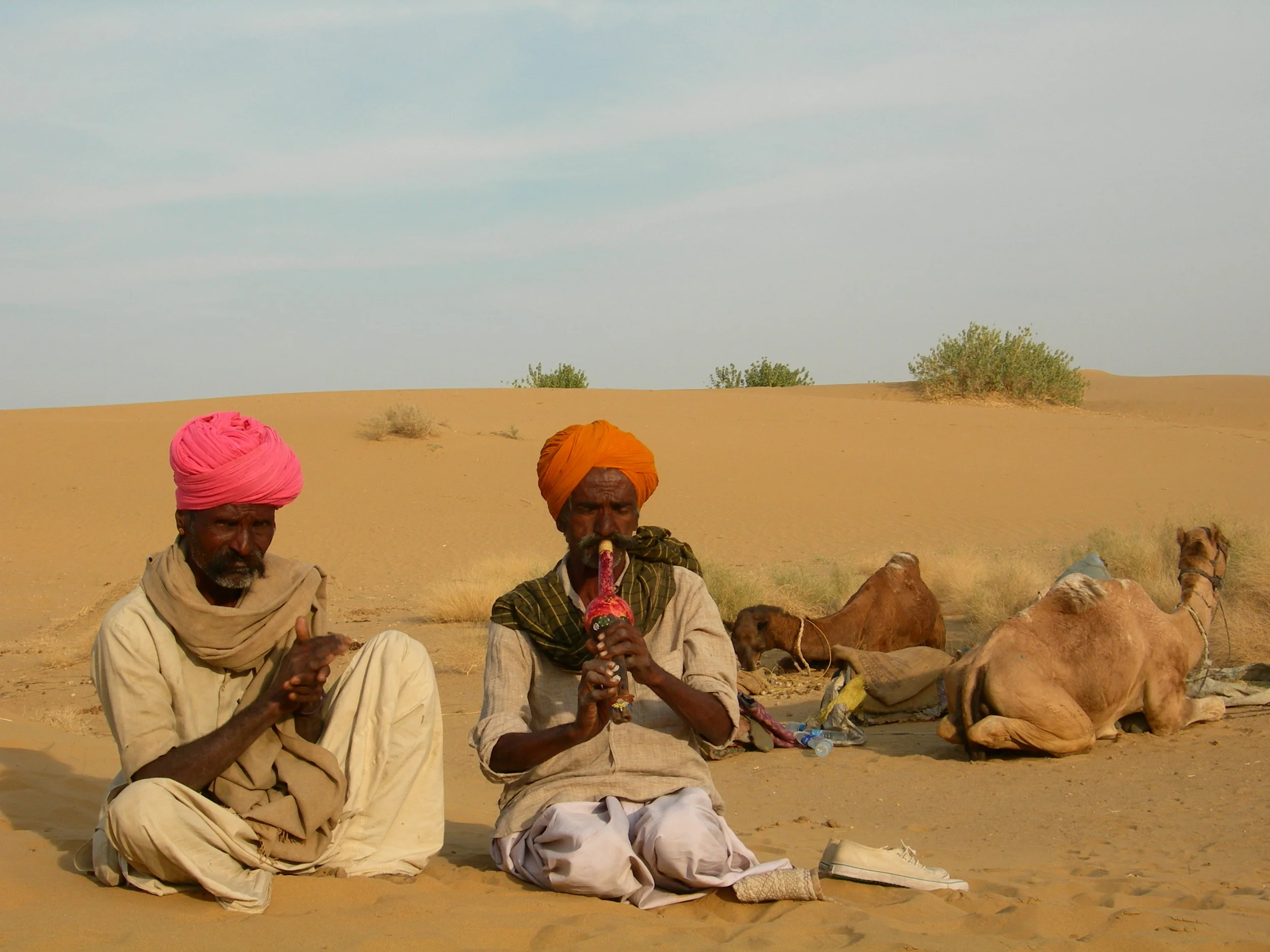3. NOMADS IN ALL CASTES & COLORS
Trying to understand caste in India is a complicated business. Primarily, caste is a signifier of vocation (and a certain amount of cleanliness/sacredness that accompanies any job). Many of the nomads in Rajasthan are not pastoral nomads and keep very few, if any, animals. Instead, they used to travel from town to town providing skills and services to villages.
Here are some of the caste groups I met in my first few weeks:
BANJARA: large category of small goods traders. Originally engaged in trading salt, natural dyes, and minerals. Now mainly sell plastic goods, jewelry and bangles.
GODOLIA LUHARS: Iron smiths (the most common type of tool makers/repairers), travel with great wooden carts and can manifest as anything from a full mobile iron melting and smithing unit to an old man with a sharpening wheel powered by a bicycle.
GHATTIWALS: Craftsmen who repair stone mills
(KUCH) BANDIYA: Traveling craftsmen who specialize in making tools for goldsmiths, painters and weavers
BHOPA: Musicians who specialize in the teller of Pabu-ji, a famous Rajasthni epic. (Not to be confused with Bhopa - higher caste priests who do puja at particular temples)
NAT: Acrobats and performers of various feats and tricks (not to be confused with Naths - fire priests from Bikaneer who do not wander) often magicians, contortionists, and tightrope walkers.
BHATTS: A large category encompassing different types of wandering storytellers and genealogists. (not to be confused with Bhats, a sub-caste of Rajasthani farmers)
KATHPUTLI BHATTS: Puppeteers and singers. Use portable stages to perform short plays using marionettes accompanied by musicians on dholok (drum), khartel (castanets) and vocals.
RAIKA & REBARI: Pastoral nomads, herders of camel, sheep and goats. Sometimes considered one group, sometimes considered two separate groups. These days most herders who call themselves Raika travel in Rajasthan, while most Rebaris are found in Gujarat and Madhya Pradesh.
KALBELIAS: Snake charmers, beggars, dancers, singers. They are connected to Jogis in ancestry (according to some, contested by others). Touted as the epic "real gypsies" of Rajasthan. Mostly, the women wander through towns begging and engaging in serious "flirtation/seduction" for money. Untouchables.
JOGI: Wandering beggars with no special vocation. They are considered by some to be cast-out ascetics and considered by some to be Kalbelias from another region. Untouchables
In the face of so much difference and diversity, I find myself constantly questioning any connection at all between these communities and the terms used to link them. North Indians I have met along the way fluctuate between lumping all of these communities under one inaccurate caste name (usually calling them all Jogis with thinly veiled contempt) or saying that these groups have nothing in common with each other. Still others were adamant that these groups no longer exist. Indeed, other than their own landlessness and incessant movement, the various nomadic castes of Rajasthan do not have much in common. It is only with settlement (most often in slums or on the outskirts of larger town/cities) that these groups mix and live in close proximity.
Aside from the Raika and other pastoralists and small groups of Banjari (small goods traders), virtually everyone has settled in one way or another. Many have settled in or around towns and cities where they can live off manual labor, low service work or beg or perform for tourists.
During my time in Rajasthan, it is difficult to not compare the identity of traditionally nomadic people of the Thar Desert to the nomadic herders that I lived with in Mongolia. For Mongolian herders, traveling was a part of life, part of the work of living off the animals and off the land, part of being home.
Communities do not tend to wander at whim. Pastoralists migrate so that their animals can eat from many places, as no one place could sustain them throughout the year. Life in Mongolia is not easy for the modern herder by any means. Still, pride in the nomadic life is strong and people have learned to live well. In the Thar Desert, I walk through a dramatically different landscape. The Manganiyars, the Kalbelia, the Nats, Banjaras and Bhopas are nomads lost in a sea of farmers, of landed people who for the most part have decided that their skills, that their ritual function is no longer useful. I am reminded of this tension often. Even the Manganiyars, famous musicians who serve their jagmans(patrons) well and keep ritual life in order, derive their name from the verb mangana (to beg).
Life for landless people has always been based on relationships of patronage based in a conviction that these groups provided necessary services for which they should be compensated. The system works so long as there remains a consensus on the worth of services rendered (in this case entertainment, genealogy and ritual performance). As India modernized, there was an abrupt societal shift that transformed the Kabelias – once the priests of snakes, magical singers and dancers, healers and wise people into roadside miners harvesting gravel and selling their daughters into prostitutions or if lucky dancing on the street for a few rupees.
In Rajasthan, I failed to meet any groups for whom there remained a joy and pride in moving from place to place. At one time, there may have been a strong narrative of identification with a vocation supported by social obligation and service. But now, people see all this movement as a form of backwardness and virtually everyone I meet thinks only of finding a way to build even a simple shelter and eventually a pucca ghar, of finding security in a settlement no matter how marginal. In Modern India, worth is measured by literacy, education, land ownership, wealth and reliable source of income. The barter system is all but dead for these clans working in goods/services and a money economy has been thrust on people who used to have little need for money. Now they are poor.



